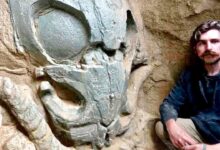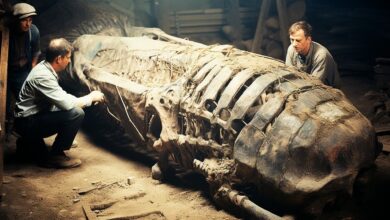Scientists Opened Pompeii Chamber, What They Found Is Much Worse
The ongoing archaeological discoveries at Pompeii continue to captivate the world, offering a rare glimpse into the daily lives, beliefs, and rituals of the ancient Romans. The eruption of Mount Vesuvius in 79 AD buried Pompeii under a thick layer of volcanic ash, effectively preserving the city and its inhabitants in time. This catastrophic event, as described by Pliny the Younger, resulted in an 18-hour bombardment of pumice and ash that forced many to flee, but tragically sealed others within their homes, where they would perish in pyroclastic flows — lethal clouds of gas and volcanic debris. The eruption preserved the buildings, artifacts, and even the forms of people, allowing modern-day archaeologists to uncover a vast array of precious items and even details of everyday life that otherwise might have been lost to history.
Pompeii remained hidden for centuries until excavations began in 1748, leading to the uncovering of roughly two-thirds of the ancient city over time. This has given scholars invaluable insights into Roman life, architecture, and customs. One of the most significant recent discoveries is that of a hidden ceremonial room as part of the Regio V excavation project. This room, complete with ritual objects and vibrant frescoes, opens a window into the religious practices of Pompeii’s residents.
The Regio V project, launched in 2018, focused on an area of the city previously unexplored, specifically targeting the northern part of Pompeii. Using state-of-the-art technology such as drones and 3D scanners, archaeologists uncovered areas that had remained sealed and untouched, many of which were located near wealthy neighborhoods. The area had suffered some damage during World War II, offering an opportunity for deeper exploration of previously undisturbed sites.
A particularly extraordinary find was made on March 14, 2021, when a sealed ceremonial room was uncovered in the House of the Enchanted Garden. This room was remarkably intact, its walls adorned with exquisite frescoes that provided a rare look at Pompeii’s private rituals. The careful sealing of this room had preserved it from both the eruption and subsequent activities, effectively creating a “time capsule” for nearly two millennia.
The House of the Enchanted Garden itself is known for its luxurious design, particularly its naturalistic garden that reflects the wealth and cosmopolitan nature of the homeowner. The newly revealed ceremonial room adds a new dimension to the understanding of the house, suggesting that it may have been used for private religious rituals. The frescoes in the room showcase a blend of traditional Roman iconography and less common symbols, such as a depiction of Persephone, the goddess of the underworld and spring renewal, accompanied by figures carrying symbolic objects like grain sheaves, pomegranates, and scrolls. These vibrant and detailed images offer a glimpse into the private, spiritual life of ancient Romans, shedding light on their practices and beliefs.
In addition to the frescoes, a newly discovered room in another part of the excavation site features a stunning array of religious symbols and rituals captured in wall paintings. While part of the ceiling has collapsed, it remains possible to restore it, with fragments of the ceiling revealing sky-blue paint adorned with golden leaf decorations in the shape of famous constellations. At the center of the ceiling, a medallion depicts a female face, possibly representing Medusa, surrounded by rays or serpents. The paintings utilize advanced techniques like spatial perspective and visual effects to create a sense of depth and dimensionality, with some images even appearing to change when viewed from different angles.
The room’s floor is equally impressive, with a large marble table featuring three lion-head legs, decorated with a swirling pattern made from different marbles, creating a rose-like shape. Three low triclinium-style chairs, still showing traces of golden silk and purple threads, surround the table. Artifacts found within the room were arranged deliberately, including a bronze stand with a shallow silver bowl that holds traces of incense and herbs, along with small ceramic jars and a glass bowl containing dried fruits, such as pomegranates and figs.
A particularly intriguing discovery is a set of small bone plates etched with symbols that have yet to be identified. These may have played a role in Roman games or divination rituals. Additionally, a small silver box was found containing 21 thin gold leaf scrolls, which are believed to contain ritual formulas and prayers directed to various gods, including unusual combinations of Greek, Roman, and possibly Egyptian deities. Nearby, a small wooden cabinet holds bronze statues of gods such as Mercury, Bacchus, Venus, as well as Egyptian deities like Isis and Anubis, further suggesting the syncretic religious practices of the period.
Among the most fascinating finds are three ceramic jars containing a liquid that has since solidified, believed to include wine, honey, and a plant compound with hallucinogenic properties, hinting at the ritualistic nature of the room’s use. Evidence of these rituals is further supported by fragments of gold leaf, cinnabar powder, and organic materials, which show that the room was actively used for religious ceremonies.
In addition to these religious artifacts, several children’s toys were found, providing insight into the involvement of children in family rituals. The presence of food remnants, such as spices like black pepper and cinnamon imported from India and Asia, suggests that these rituals were not just spiritual, but also involved communal meals. The discovery of Egyptian gods and exotic foods underscores the cultural exchange that took place in the Mediterranean world of Rome.
Sewing tools and fabric fragments were also discovered, shedding light on the daily life of the family that used this space. These findings reflect the role of women in both domestic and religious activities. Advanced technologies, including detailed photography and 3D mapping, have allowed for precise documentation and preservation of these findings, providing a more complete picture of how this space functioned.
Microbial analysis has further revealed unique fungi species that have developed over the past two thousand years, helping scientists understand the ancient environment of Pompeii. However, several mysteries remain unresolved. The bone plates with unidentified symbols, the cryptic gold leaf scrolls, and the strange liquids in the jars still present questions about the specific religious practices and rituals of this family, suggesting that their customs may have extended beyond traditional Roman practices.
This room and the artifacts discovered within it provide new insights into the complexity of Roman religion, daily life, and cultural exchange. Each new discovery at Pompeii deepens the mystery of this remarkable city and its inhabitants, offering a window into a world that was lost but is now slowly being revealed once again.








